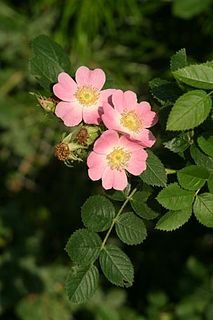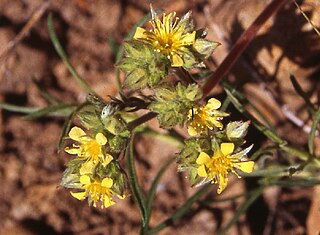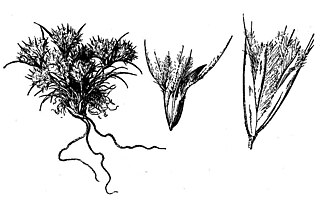
The rose subfamily Rosoideae consists of more than 850 species, including many shrubs, perennial herbs, and fruit plants such as strawberries and brambles. Only a few are annual herbs.

Lewisia is a plant genus, named for the American explorer Meriwether Lewis (17741809) who encountered the species in 1806. The native habitat of Lewisia species is north facing cliffs in western North America. Local Native Americans ate the roots, which have also been used to treat sore throats.

Psorothamnus is a genus of plants in the legume family. These are shrubs and small trees. Many are known by the general common name indigo bush. Some are referred to as daleas, as this genus was once included in genus Dalea. These are generally thorny, thickly branched, strongly scented bushes. Most species bear lupinlike raceme inflorescences of bright purple legume flowers and gland-rich pods. Psorothamnus species are native to the southwestern United States and northern Mexico. The genus is paraphyletic and it has been proposed that the genus Psorodendron be reinstated to accommodate sections Xylodalea, Capnodendron, and Winnemucca.

Ivesia is a genus of flowering plants in the rose family known generally as mousetails. They are perennial herbs native to western North America, especially the western United States. Plants of this genus are sometimes treated as members of genus Potentilla.

Ivesia aperta is a species of flowering plant in the rose family known by the common name Sierra Valley mousetail.

Ivesia jaegeri, is an uncommon species of flowering plant in the rose family known by the common name Jaeger's mousetail, or Jaeger's ivesia.

Ivesia lycopodioides is a species of flowering plant in the rose family known by the common name clubmoss mousetail, or clubmoss ivesia. It is native to the Sierra Nevada and to regions east of the range in California. It may also be found beyond the state line into Nevada. This is a perennial herb which grows in the crevices of rock ledges in the mountains and in wet high-elevation meadows. It produces a rosette of flat to cylindrical leaves up to 15 centimeters long, each of which is made up of many tiny, lobed leaflets. The stems may grow erect or drooping to 30 centimeters long and each holds an inflorescence of clustered flowers. Each flower has hairy, greenish triangular sepals and much larger oval-shaped petals of bright yellow. In the center of the flower are usually five stamens and several pistils. There are three subspecies.

Ivesia webberi is a species of flowering plant in the rose family known by the common names wire mousetail and Webber's ivesia. It is native to the United States, where it occurs in the northernmost part of the Sierra Nevada and the adjacent Modoc Plateau in California, its range extending just into Nevada.

Blepharidachne kingii is a species of grass known by the common name King's eyelashgrass. It is native to the Great Basin in the United States, where it grows in habitat such as pinyon-juniper woodland. It is rare in California and Idaho, but it is one of the most common grasses of the northeastern deserts of Nevada.

Ivesia baileyi is a species of flowering plant in the rose family known by the common name Bailey's ivesia.

Potentilla diversifolia or Potentilla × diversifolia is a species of flowering plant in the Rose Family (Rosaceae) known by the common names varileaf cinquefoil, different-leaved cinquefoil, and mountain meadow cinquefoil.
Potentilla newberryi is a species of cinquefoil known by the common name Newberry's cinquefoil. It is native to the Pacific Northwest of the United States from Washington to the northeastern Modoc Plateau in California and Nevada.

Geum rossii is a species of flowering plant in the rose family known by the common names Ross' avens and alpine avens. It is native to North America where its distribution spans northern Canada and the high mountains of the western United States. It grows at high-latitude and high-elevation habitat, including the Arctic and in alpine climates. There are three varieties. One, var. depressum, is endemic to Washington in the United States, where it is limited to the Wenatchee Mountains.

Eriogonum argophyllum is a species of wild buckwheat known by the common names Sulphur Hot Springs buckwheat, Silver Lake buckwheat, and Ruby Valley buckwheat. It is endemic to Nevada in the United States, where there is only one known population.
Ivesia rhypara is a species of flowering plant in the rose family known by the common name grimy mousetail, or grimy ivesia. It is native to Oregon and Nevada in the United States.

The flora of the U.S. Sierra Nevada alpine zone is characterized by small, low growing, cushion and mat forming plants that can survive the harsh conditions in the high-altitude alpine zone above the timber line. These flora often occur in alpine fell-fields. The Sierra Nevada alpine zone lacks a dominant plant species that characterizes it, so may or may not be called a vegetation type. But it is found above the subalpine forest, which is the highest in a succession of recognized vegetation types at increasing elevations.

Drymocallis glandulosa, known by the common name sticky cinquefoil and formerly as Potentilla glandulosa, is a plant species in the family Rosaceae.

Trifolium kingii, the King's clover, is a perennial clover in the legume family (Fabaceae)

















